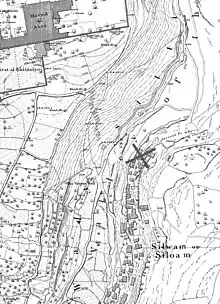Shebna inscription
The Shebna Inscription or Royal Steward Inscription, known as KAI 191, is an important Proto-Hebrew inscription found in the village of Silwan outside Jerusalem in 1870. After passing through various hands, the inscription was purchased by the British Museum in 1871.[1]
| Shebna inscription | |
|---|---|
 Shebna inscription | |
| Material | Limestone |
| Size | 160cm long, 52 cm high |
| Created | 7th century BCE |
| Present location | British Museum, London |
| Identification | 1871,1107.1, WA 125205 |
The inscription is broken at the point where the tomb's owner would have been named, but biblical scholars have suggested a connection to Shebna, on the basis of a verse in the Bible mentioning a royal steward who was admonished for building a conspicuous tomb.
It was found by Charles Simon Clermont-Ganneau, about a decade prior to the Siloam inscription, making it the first ancient Hebrew inscription ever found.[2] Clermont-Ganneau wrote about three decades later: "I may observe, by the way, that the discovery of these two texts was made long before that of the inscription in the tunnel, and therefore, though people in general do not seem to recognise this fact, it was the first which enabled us to behold an authentic specimen of Hebrew monumental epigraphy of the period of the Kings of Judah."[3]
The text is considered to have a "remarkable" similarity to that of the Tabnit sarcophagus from Sidon.[4]
Discovery

The inscribed lintel was found by French archaeologist, Charles Simon Clermont-Ganneau in 1870 above the entrance to a home in Silwan, a historical Palestinian village south of Jerusalem. Clermont-Ganneau arranged for the inscription to be purchased and removed by the British Museum one year after its discovery.
Description
The limestone inscription was so severely damaged that it was not possible to completely decipher the script until 1952. Nevertheless, the inscription is significant because it allegedly describes a figure from the Bible called Shebna who was sent by King Hezekiah to negotiate with the Assyrian army. The three-line Hebrew funerary inscription indicates that the cave was the tomb of Shebna, the royal steward of King Hezekiah (715–687 BCE).
Inscription text
The writing is in Biblical Hebrew in the Paleo-Hebrew script and can be dated to the seventh century BCE. The transliteration below is to Square Hebrew script, invented about 400 years after the actual inscription.
| Square script | זאת [קבורת ...]יהו אשר על הבית. אי[ן פה] כסף ו[ז]הב אם [עצמותיו ועצמות] אמתה אתה. ארור הא[דם] אשר יפ[תח] את זאת |
| Transliteration | z’t [qbwrt …]yhw ’šr ‘l hbyt. ’y[n ph] ksp w[z]hb ’m [‘ṣmwtyw w‘ṣmwt] ’mth ’th. ’rwr h’[dm] ’šr yp[tḥ] ’t z’t |
| Romanization | zot [qebarot ...]yahu ’asher ‘al ha bayt. ’ay[n peh] kesep we [za]hab ’im [‘atzemotaw we ‘atzemot] ’amatoh ’itoh. ’arur ha ’a[dam] ’asher yip[tach] ’et zot |
| Translation | This is ... [... ...] ...iah, the royal steward.[5] There is no silver or gold here only ... [his bones] ... and the bones of his maidservant with him. Cursed be the man who opens this |
The "maidservant" is referred to by the Hebrew ‘amatah, equivalent to the term "handmaiden" used to refer to concubines at various points in the Torah.
Royal Steward of Judah
The royal steward or court chamberlain was a powerful figure in Ancient Judah. According to the Book of Isaiah (Isaiah 22:15–16), the royal steward appointed by King Hezekiah was called Shebna and he was admonished for building himself too grandiose a tomb. Although the name of the royal steward is broken at the point where the official is named, it has been conjectured on the basis of the biblical verse that this monumental inscription originates from the tomb of Shebna.
See also
References
- British Museum Collection
- Avigad, N. (1953). The Epitaph of a Royal Steward from Siloam Village. Israel Exploration Journal, 3(3), 137-152: "The inscription discussed here is, in the words of its discoverer, the first ‘authentic specimen of Hebrew monumental epigraphy of the period of the Kings of Judah’, for it was discovered ten years before the Siloam tunnel inscription. Now, after its decipherment, we may add that it is (after the Moabite Stone and the Siloam tunnel inscription) the third longest monumental inscription in Hebrew and the first known text of a Hebrew sepulchral inscription from the pre-Exilic period."
- Clermont-Ganneau, 1899, Archaeological Researches In Palestine 1873-1874, Vol 1, p.305
- Christopher B. Hays (2010), Re-Excavating Shebna's Tomb: A New Reading of Isa 22, 15-19 in its Ancient Near Eastern Context, Zeitschrift für die Alttestamentliche Wissenschaft; "The similarity of the inscription to that of Tabnit of Sidon (KAI1.13, COS2.56) is remarkable, extending even to the assertion that there are no precious metals within"
- The "royal steward" - literally "upon the house".
Further reading
- F. Frances (Ed), Treasures of the British Museum, London, 1972
- D. Colon, Ancient Near East Art, British Museum Press, London, 1995